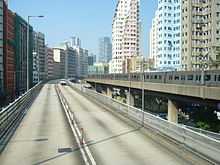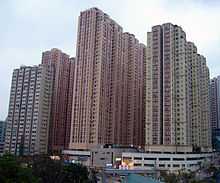Ngau Tau Kok



Ngau Tau Kok (Chinese: 牛頭角; Jyutping: ngau4 tau4 gok3) is an area of Kowloon East, located at the northern part of Kwun Tong District, next to Kowloon Bay. It covers Jordan Valley, Ngau Tau Kok and Upper Kwun Tong town centre. The population of Ngau Tau Kok exceeds 210,000. It is one of the major residential areas in Kwun Tong District.
Geography
In Chinese, Ngau Tau Kok means ox horn or ox head cape: before the reclamation of Kowloon Bay, the coastline of Ngau Tau Kok was shaped like the horn of an ox. Ngau Tau Kok includes two hills - Jordan Valley (Shum Wan Shan) and Crocodile Hill (Lok Yue Shan), where around half of the residential blocks are located.
Features

Ngau Tau Kok is a residential area close to the town centre of Kwun Tong District. The area around Lower Ngau Tau Kok Estate is known for its street food, including congee, noodles and other traditional Cantonese cuisine. In summer, Ngau Tau Kok hosts many religious ceremonies to cerebrate the Yu-lan festival, a festival from Chinese ghost tales.
History
Ngau Tau Kok has a long history of Hakka inhabitants. In the early colonial days of Hong Kong, it was one of the four hills of Kowloon (九龍四山) in eastern Kowloon where granite was extracted. The granite from Ngau Tau Kok was transported to Victoria City on Hong Kong Island across Victoria Harbour. Some stone was even exported to Canton City for the construction of its Sacred Heart Cathedral.
Before being a residential area, Ngau Tau Kok was an industrial area. Amoy Food sited a factory in Ngau Tau Kok to manufacture soy sauce. A high-density private housing estate, Amoy Gardens was constructed on the factory site.
A reservoir in Jordan Valley formerly provided fresh water to Ngau Tau Kok but is now disused and used as a landfill area. An artillery battery was also located in Jordon Valley but it was removed to make way for the urban development project.
The site of the MTR Kowloon Bay Depot was formerly the Ngau Tau Kok Industrial Estate.

SARS outbreak
During the spring of 2003, Ngau Tau Kok was severely impacted by the SARS outbreak. A concentration of cases of the deadly disease occurred in Amoy Gardens (淘大花園), mainly in its Block E. The drainage design (which was widely used across Hong Kong) was later criticised and amended.
Town Gas explosion
On 11 April 2006, a fatal underground explosion occurred in Ngau Tau Kok Road and Jordan Valley North Road: two people died and eight were injured. Wai King Building (偉景樓) was seriously damaged by the blast which was caused by leakage of town gas from underground pipes belonging to Hong Kong and China Gas, a major local utility.
Transport
| Wikimedia Commons has media related to Ngau Tau Kok. |
Major roads in Ngau Tau Kok include:
- Choi Ha Road
- Chun Wah Road
- Elegance Road
- Kung Lok Road
- Ngau Tau Kok Road
- Shun Lee Tsuen Road
A MTR station in the northern part of Ngau Tau Kok is named Kowloon Bay; the Ngau Tau Kok MTR station is located in the southern part of Ngau Tau Kok. Both stations are on the Kwun Tong Line.